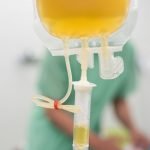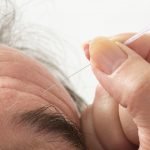A Case for the History Books: How Biotherapeutic Drainage Stimulated Healing in Resistant Eczema
Robert Abell, ND, LAc
Skin has always presented unique and challenging issues for the medical profession. When I am presented with a “dermatology” case, there are many issues that must be taken into account. This is very different from the allopathic approach to this topic. My philosophy originated in Portland, Oregon, at the National College of Naturopathic Medicine (now National College of Natural Medicine) with the guiding support of my professors and clinical physicians, but my true understanding of dermatology came when I met Dr Gerard Gueniot.
Biotherapeutic Drainage
Dr Gueniot was a French MD who was the most natural thinking physician I had ever met. He introduced me to the philosophy of medicine termed biotherapeutic drainage, which is a complex way of treating our patients because it does not address symptoms but instead takes the physiology into account. If 100 dermatology cases were presented to me, I would not be too concerned with the diagnosis. As we all know, the diagnosis of the skin is difficult, and even dermatologists are unsure of the cause of disease in many cases. Dr Gueniot always taught that to truly heal a patient we must return him or her to a normal physiological state. He would always stress physiology over pathology, admonishing us to stop focusing on the pathology because it is merely the manifestation of an altered normal physiology. If you return a patient to normal physiology, the pathology must resolve with it. Unfortunately, this philosophy is not understood in allopathic medicine.
To treat the skin with biotherapeutic drainage, one must understand skin physiology, which is a 4-step process. The first 2 concepts are explained in Traditional Chinese Medicine as follows: (1) a peripheral manifestation of an internal homeostatic issue involving the liver, spleen, pancreas, kidney, heart, or lung and (2) the great functions of the skin (ie, jing, shen, and the triple warmer). The other 2 concepts include the following: (3) skin manifestations (we always ask when, since when, where, where to, and how and about concomitant symptoms) and (4) miasmatic function (psora eliminates, sycosis overflows, tuberculinic occupies, and luetic metastasizes). By entertaining these 4 ideas, one is able to elicit the true cause of any dermatology case.
Enough about physiology. The following case shows the true power of biotherapeutic drainage.
Sophia’s Case
In 2007, I was referred an eczema case from an old acupuncture schoolmate of my wife. She had a good friend with a 4-year-old daughter who began having skin problems at about age 4 months. Treatment began with a change in her foods, which had no effect, and then on the advice of her pediatrician, they added corticosteroid creams. At first, the creams reduced the inflammation, but as they were stopped, the eczema came back worse than before. This is typical when corticosteroids are used on the skin. After 3½ years of constant topical and oral corticosteroid use, her parents were at their wit’s end.
When I met with Sophia and her parents for the first time, her skin was edematous, erythematous, and oozing a thick yellow exudate (Figure 1). She stated that it itched 24 h/d, which prevented her from sleeping normally. In the past 3½ years, her parents said that they had not slept more than 2 hours at a time because of Sophia’s severe skin itching. Even while her skin was at its best when using the corticosteroid creams, she still itched intensely. It was by far the worst case of eczema I had ever seen. Children her age would see her skin and run away frightened. She only played with her cousins, who understood that there was nothing dangerous about her. The eczema involved her face, ears, chest, abdomen, back, legs, arms, and hands. Her parents had brought her to me as a last resort. Her physicians had no more answers. She also had allergies to the seasonal winds that we get in southern California, called the Santa Ana. Her abdomen was extremely enlarged and reminded me of a child with severe malnutrition.
One notable concomitant symptom was that her skin worsened when her digestion was affected. This is typical of psoric individuals. The psoric is susceptible to digestive, respiratory, and skin issues. As Dr Samuel Hahnemann stated, the psoric eliminates centrifugally. They eliminate by pushing their toxins to the outside. Because the skin and mucous membranes are the outer surfaces of the body, psorics always have issues in these areas. Sophia was the typical psoric because her symptoms improved when eliminating (ie, via bowel movements, vomiting, skin discharge, etc). Psorics always experience better health when the body is pushing outward. This can even involve the mental and emotional sphere. For example, a psoric may feel more at peace and less anxious after having a bowel movement.
General signs were that Sophia manifested insomnia because of severe itching, had several stages of skin reaction (improving and then worsening for no known reason), disliked water and bathing, maintained energy and a good mood even when her skin was bad, disliked hot weather and hot water, and always experienced improvement in her skin after a bowel movement. Objective signs included that she had a very dilated and swollen face and body, was highly talkative and social, loved being with people, and had a hot body temperature and sweaty and moist skin.
Anyone familiar with homeopathy can clearly see a Sulfur nature in Sophia, but Sulfur was not the only remedy that I used. In biotherapeutic drainage, we always determine if the patient’s emunctories are open and functioning. An emunctory is basically a normal physiological route of excretion from the body. This is first and foremost to determine. You can give all the nutrients, vitamins, botanicals, nutraceuticals, and so forth from your pharmacy, but if your patient is not eliminating correctly, you are just adding to the toxic load. We must be able to eliminate first, and then we can support and heal with other modalities.
Treatment was initiated with an ascending dose of Sulfur (7CH, 9CH, 12CH, 15CH, and 30CH) over 5 days along with homeopathic drainage, including Berberis (30K) to increase kidney function and Urtica urens (30K) to drain the skin. Ribes nigrum gemmotherapy was used to reduce inflammation and strengthen the adrenal function owing to the corticosteroid use. I also added Borage oil, which in my opinion is the best oil to reduce skin inflammation. Probiotics were used, and we must always remember that a properly functioning digestive system is the key to one’s health. This is especially important in children, who have less mature gut function than adults. Another important point to remember is that all remedies should be used short term and altered to avoid a dependence on them. This is why I see patients every 2 months to adjust their remedies. Last, I gave Sophia 2 ointments, Calendula cream and Cicatrisan cream. Calendula is wonderful for children because it is water soluble, and Cicatrisan cream prevents infection.
After 2 months, Sophia returned with basically the same skin symptoms. This did not surprise me because she had been using corticosteroid medications for so long. In my experience, patients who use corticosteroids always take longer and are harder to treat, and patience must be a physician’s virtue. I adjusted her drainage because I suspected that Sophia had a parasitic infection. This is very common in children, and it made clinical sense because of her extended abdomen and the fact that her symptoms always worsened at night. I also added Juglans regia gemmotherapy to help address Sophia’s parasites and dysbiosis. Juglans is considered a spleen qi tonic from the Traditional Chinese Medicine perspective. The final adjustment was eliminating all tomatoes, soy, and dairy products from Sophia’s diet.
Evolution of Healing
I continued to treat Sophia for the next 10 months, and each time I saw her, she had either improved or was having a “healing crisis.” At one point approximately 6 months into the treatment protocol, Sophia’s mother called me in a panic. She had developed large fluid-filled blisters all over her chest and axilla regions (Figure 2). They developed over 3 to 4 days and would become so engrossed that they would burst, leaving an erythematous lesion. What was significant about this event was that Sophia felt much better after all the lesions had excreted the fluid. In my opinion, this was a very positive sign and one that must not be suppressed. Sophia’s parents had to have extreme trust in me to get through this healing crisis, but once they realized that she was vastly improved, they knew we were going in the right direction.
Throughout the treatment process, I used numerous homeopathic remedies (Calcium carbonicum, Medorrhinum, Belladonna, Psorinum, Viola tricolor, and Rhus toxicodendron). Each of these remedies fit Sophia’s picture, and each had a positive effect. Based on my experience among children with eczema, a low dose of Belladonna (7CH or 30K) has the best overall effect in reducing the inflammatory state of the skin. Most of the remedies that were used in Sophia’s case are considered psoric by nature. In other words, they work on the psoric miasm by pushing toxins out of the body. By no means are all skin issues psoric. All the miasms must be considered in dermatological diseases. A miasm is our inherited or acquired ability to eliminate normal physiological and iatrogenic toxins.
After 1 year, Sophia’s skin finally started to heal. I still see Sophia about every 6 months for a “tune-up.” Her last visit was approximately 2 months ago, and she had no sign of eczema. She has been this way for the past 2 years. She is now able to eat everything except soy. Sophia is one of the most wonderful, happy, well-adjusted, and delightful children in my practice. I tell her that the issues with her skin were a blessing because she will never take her health for granted. I instruct students to stop focusing on the diagnosis and to start treating the patient. I never treated Sophia’s eczema; I just treated her “abnormal physiology.”
 Robert Abell, ND, LAc was awarded his bachelor of science degree in exercise physiology from the University of Colorado, Boulder, in 1985. He received his doctorate of naturopathic medicine from the National College of Naturopathic Medicine (Portland, Oregon) in 1993 and his masters in Chinese medicine and acupuncture from the Oregon College of Oriental Medicine (Portland) in 1994. Dr Abell currently lectures on various topics throughout North America, focusing on biotherapeutic drainage. Dr Abell resides and operates a multidisciplinary clinic in Orange County, California, with his wife, Lisa.
Robert Abell, ND, LAc was awarded his bachelor of science degree in exercise physiology from the University of Colorado, Boulder, in 1985. He received his doctorate of naturopathic medicine from the National College of Naturopathic Medicine (Portland, Oregon) in 1993 and his masters in Chinese medicine and acupuncture from the Oregon College of Oriental Medicine (Portland) in 1994. Dr Abell currently lectures on various topics throughout North America, focusing on biotherapeutic drainage. Dr Abell resides and operates a multidisciplinary clinic in Orange County, California, with his wife, Lisa.









